Ever wondered how to transform your bedroom into a peaceful sanctuary that feels both stylish and calming? Minimalist bedroom design has become incredibly popular for its ability to create a serene, clutter-free space that promotes relaxation and mental clarity. Its clean lines, simple color palettes, and thoughtful organization not only make a room look effortlessly chic but also help you unwind after a hectic day.
In this article, you’ll discover a wealth of inspiration and practical ideas to elevate your bedroom’s serenity through minimalist design. From clever storage solutions to subtle textures and calming color schemes, we’ll explore a variety of ways to keep your space simple yet stunning. Whether you’re starting fresh or just looking for small tweaks, these ideas will guide you toward a harmonious bedroom that feels both elegant and tranquil.
1. Opt for a Neutral Color Palette to Create Calmness
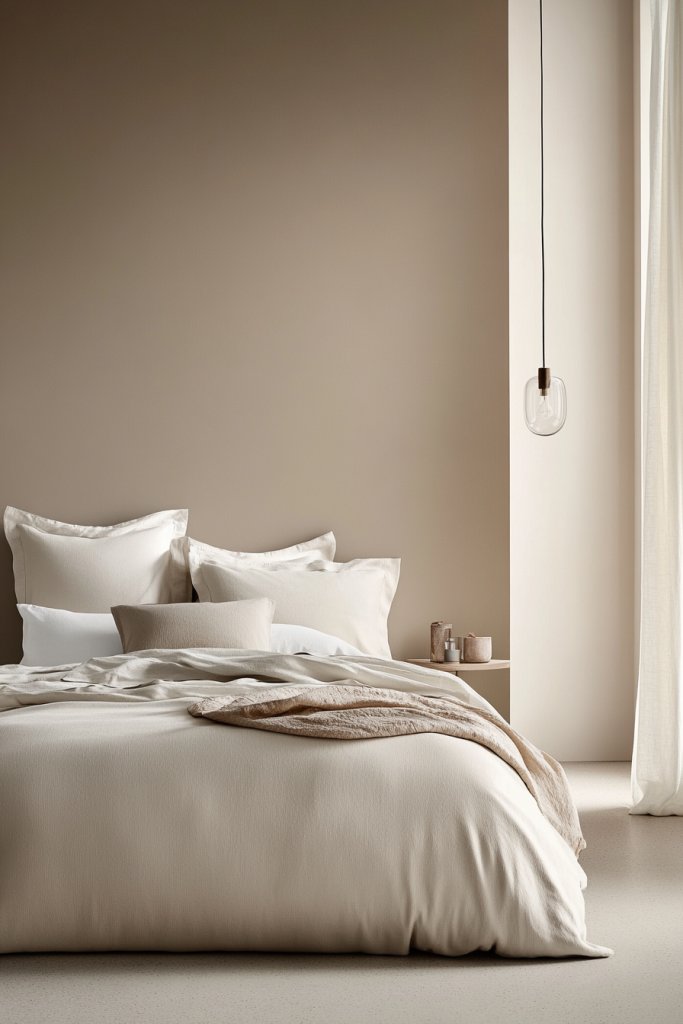
Creating a serene and peaceful bedroom starts with choosing a neutral color palette, which instantly sets a calming tone. Soft shades like warm beiges, gentle greys, creamy whites, and muted taupes serve as a soothing backdrop that minimizes visual clutter and promotes relaxation.
This approach helps your space feel open, airy, and inviting, making it easier to unwind after a busy day. Plus, neutral tones are incredibly versatile, allowing you to easily update other elements like textiles or accessories without clashing.
Imagine walking into a bedroom painted in a subtle, warm beige, with crisp white bedding and light grey accents. The walls reflect soft natural light, enhancing the room’s tranquil atmosphere.
Texture plays a key role here—think a plush, oatmeal-colored throw blanket with a chunky knit pattern and smooth linen curtains in a matching hue. The overall aesthetic is understated but sophisticated, with a focus on comfort and simplicity.
The space feels calm and balanced, inviting restful sleep and quiet reflection. To achieve this look, start with a neutral base for your walls—consider matte or eggshell finishes for a soft, non-reflective surface.
Select bedding and textiles in shades of cream, taupe, or pale grey, prioritizing natural fabrics like linen or cotton for a relaxed feel. Keep accessories minimal: a simple ceramic vase or a textured woven basket can add subtle visual interest. The key is to avoid bright or busy colors, instead focusing on creating a cohesive, harmonious environment that soothes both the eyes and mind.
2. Incorporate Low-Profile Bed Frames for a Sleek Look
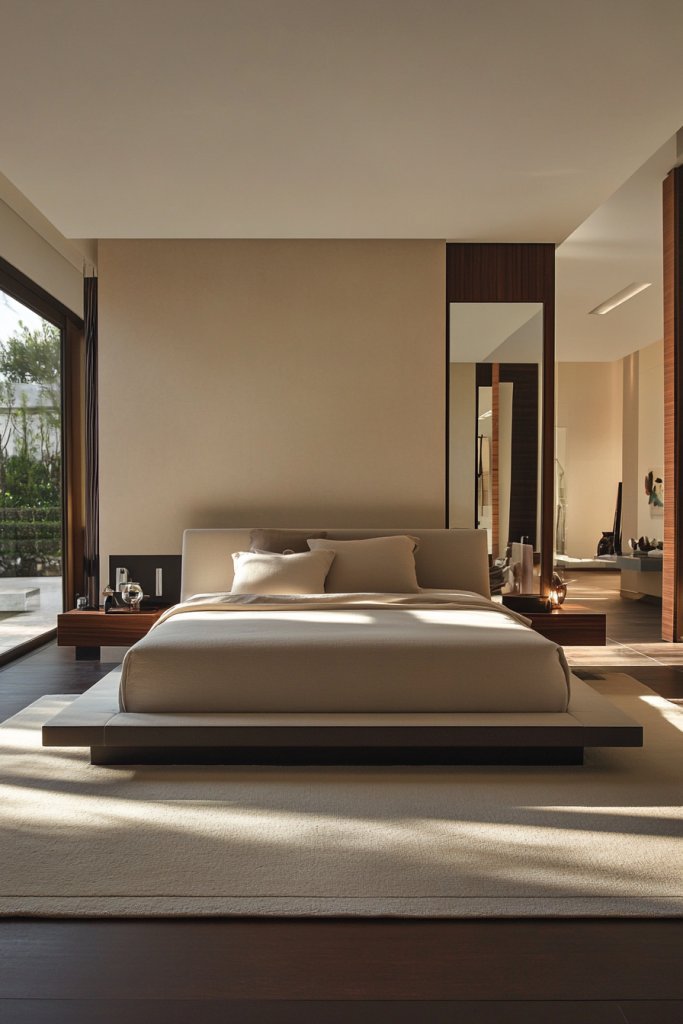
A low-profile bed frame is a hallmark of minimalist bedroom design, offering a sleek, modern aesthetic while making the space feel larger and more open. These beds sit closer to the ground, with clean lines and unembellished frames that emphasize simplicity.
They often feature materials like light wood, matte metal, or upholstered fabric, blending seamlessly into a serene, clutter-free environment. The low height creates a sense of grounded stability, anchoring the room without overwhelming it.
Picture a bed with a slim, matte black metal frame, paired with crisp white bedding and a simple, padded headboard in a neutral tone. The mattress appears to almost float above the floor, and the space beneath is often left open or used for discreet storage.
The absence of bulky headboards or ornate details allows the eye to focus on clean lines and subtle textures. This setup promotes a clutter-free vibe, making the entire room feel more spacious and restful.
To incorporate a low-profile bed, choose a frame made from durable, minimalist materials—like natural wood with a smooth finish or sleek metal. Measure your space carefully to ensure enough clearance, especially if you plan to add under-bed storage or rugs.
Assemble the frame according to manufacturer instructions, and layer with simple, unadorned bedding in monochromatic or limited tones. Keep bedside tables small or wall-mounted to maintain the streamlined look, and remember, less is more when it comes to achieving that calm, minimalist aesthetic.
3. Use Hidden Storage Solutions to Maintain Clutter-Free Space
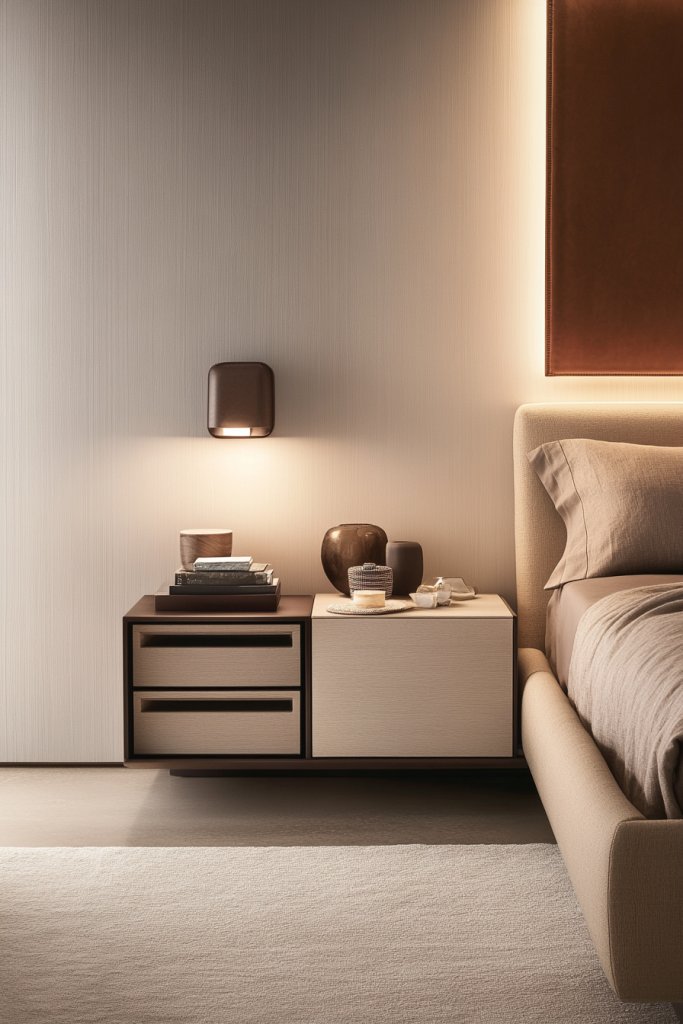
Hidden storage is essential for keeping a minimalist bedroom tidy and serene. Discreet compartments, built-in drawers, or furniture with concealed compartments help eliminate visual clutter, allowing your space to breathe.
This approach supports the minimalist principle of “less is more,” ensuring that only essential and meaningful items are on display. Well-designed hidden storage also maximizes functionality without sacrificing style.
Envision a bed with an integrated lift-up mattress that reveals a spacious storage area underneath, perfect for stowing away extra bedding, seasonal clothing, or shoes. Alternatively, sleek, low-profile ottomans or benches with hollow interiors can serve as both seating and storage, with soft, neutral upholstery that blends seamlessly with the room’s aesthetic.
Wall-mounted cabinets or floating shelves with hidden compartments can also keep everyday essentials out of sight but easily accessible. These solutions create a clean, organized atmosphere that feels uncluttered and calming.
To implement hidden storage, start by evaluating your needs: identify items that tend to clutter your space, then choose furniture pieces designed with concealed compartments. Opt for furniture in neutral finishes—like matte wood or painted MDF—that complement your color palette.
Use storage baskets or boxes in matching tones to further hide personal items. When arranging, keep surfaces clear and focus on maintaining a streamlined look, allowing your room’s natural serenity to shine through.
4. Add Textured Throw Blankets and Pillows for Subtle Warmth
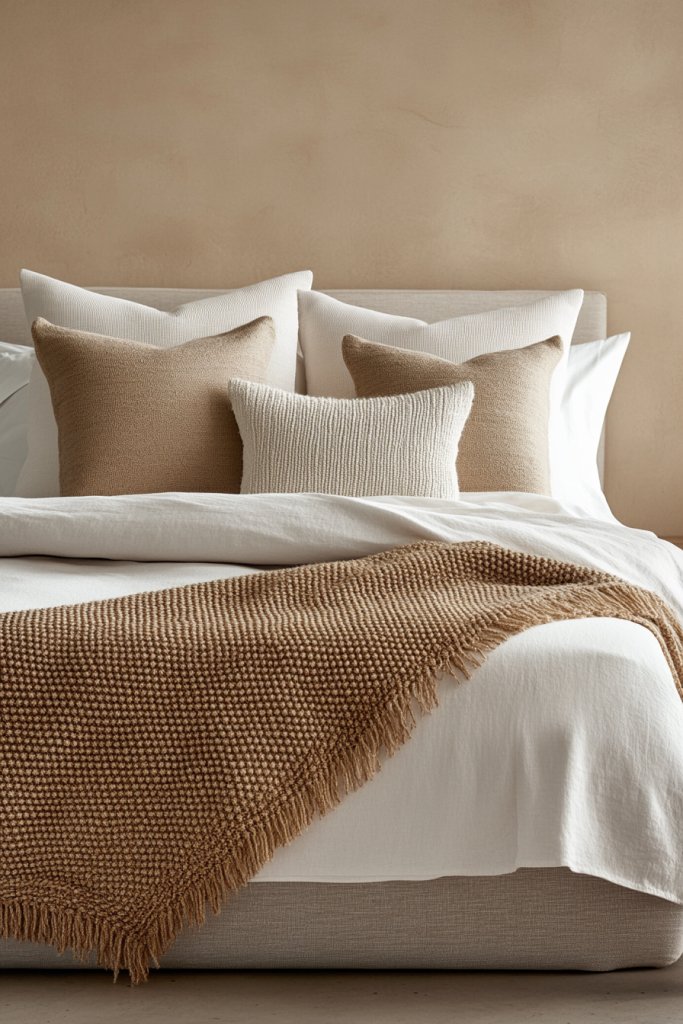
While minimalist bedrooms emphasize simplicity, incorporating textured throw blankets and pillows introduces a layer of warmth and tactile interest that elevates the space without cluttering it. These accents should be subtle, using natural materials like wool, boucle, or chunky knits in neutral tones to complement the overall calm aesthetic.
Texture invites a cozy feeling and makes the room feel thoughtfully curated, even in its simplicity. Visualize a bed with a soft cream throw blanket in chunky knit draped casually at the foot, alongside a couple of pillows with woven or ribbed fabric covers in muted shades.
The tactile contrast between smooth linens and textured textiles creates visual depth, making the bed look inviting and layered. These elements also enhance the sensory experience—imagine running your hand over the plush pillow or feeling the warmth of the knit throw—adding to the room’s serenity and comfort.
To incorporate textured accents, choose a few key pieces—like a wool throw in a neutral hue and a couple of decorative pillows with subtle patterns or ribbing. Keep colors consistent with your palette to maintain harmony.
Drape the throw loosely and arrange pillows in a relaxed manner to evoke casual elegance. These small touches go a long way in making your minimalist bedroom feel cozy and personal, without disrupting the clean, uncluttered vibe.
5. Select Minimalist Nightstands with Clean Lines

A sleek, minimalist nightstand can instantly elevate the serene vibe of your bedroom while providing essential storage without clutter. Choosing the right piece creates a sense of calm and order, making your space feel more open and intentional.
Picture a nightstand crafted from smooth, matte-finished wood or a simple lacquered surface in neutral tones like soft beige, cool gray, or crisp white. It features straight, unembellished lines with no ornate detailing—perhaps a single drawer or an open shelf.
The size is proportionate to your bed, not overpowering but functional, with enough surface space for a minimalist lamp, a book, or a small decorative object, like a ceramic vase or a simple sculpture. The overall effect is a clean, uncluttered look that complements the bed and the rest of your furnishings, creating visual harmony and a calming atmosphere.
To implement this, start by measuring your bedside space and choosing a nightstand with simple, straight lines that match your room’s color palette. Opt for materials like light wood, metal, or engineered wood with a matte finish—these are budget-friendly and easy to maintain.
Look for designs with built-in storage or hidden compartments to keep surfaces clear. Assemble your chosen piece according to the instructions, and keep accessories minimal: perhaps a small table lamp, a clock, or a few favorite books. This straightforward approach ensures your nightstand enhances your minimalist sanctuary effortlessly.
6. Install Recessed or Track Lighting for Soft, Ambient Illumination
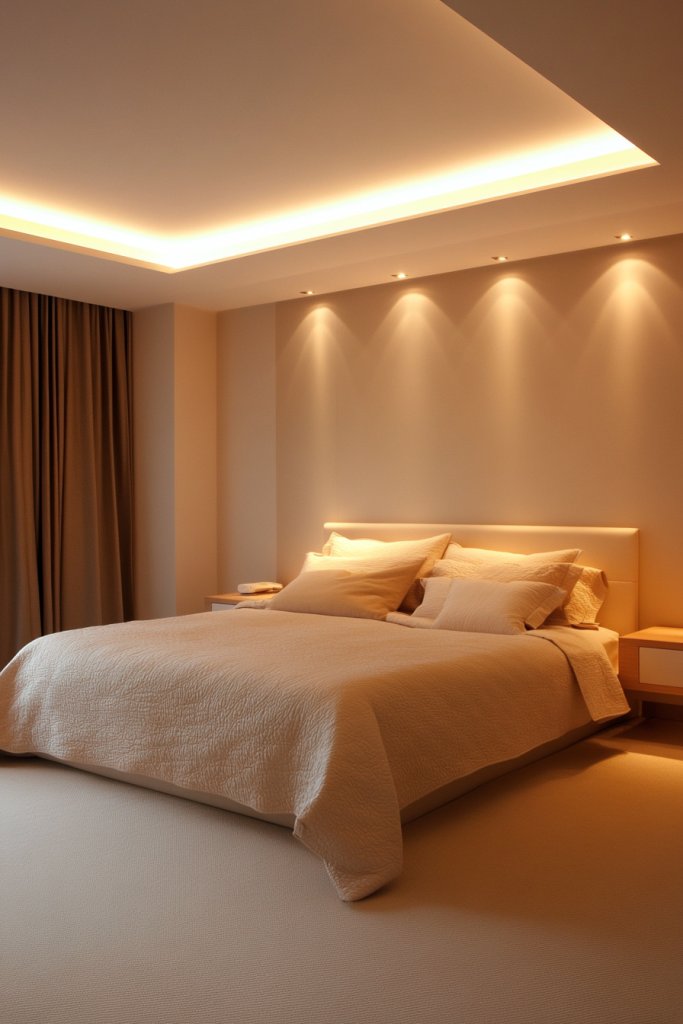
Lighting plays a crucial role in cultivating a peaceful, minimalist bedroom. Recessed or track lighting provides gentle, diffused illumination that creates a cozy, inviting atmosphere without overwhelming visual clutter.
Imagine soft, warm light emanating from sleek, slim fixtures installed directly into the ceiling—recessed lights that appear almost invisible or track lighting with adjustable heads capturing different angles. When turned on, the light spreads evenly across the room, highlighting textures like smooth walls or plush bedding, while casting subtle shadows that add depth.
The result is a soothing glow that transforms your space into a tranquil retreat, perfect for winding down or relaxing. To achieve this look, first assess your ceiling’s structure and decide whether recessed or track lighting suits your space best.
For a straightforward installation, choose LED fixtures with dimmable options to control brightness and create the ideal ambiance. If you’re not comfortable with electrical work, consider hiring a professional.
Select fixtures in matte black, brushed nickel, or white for a minimalist aesthetic. Position the lights to highlight key areas—such as the bed, a reading nook, or artwork—and ensure the lighting setup provides even, soft illumination. With simple tools and a bit of planning, you can create a serene, well-lit bedroom that feels both modern and calming.
7. Use Wall-Mounted Headboards to Maximize Floor Space

Wall-mounted headboards are a smart, stylish way to add elegance and save space in a minimalist bedroom. By anchoring the bed directly to the wall, you eliminate bulky furniture and create a streamlined, open feel.
Visualize a low-profile, rectangular panel made from smooth wood, upholstered fabric, or even a simple painted wall feature that extends just behind your mattress. The headboard is flush with the wall, often with hidden mounting hardware, giving a clean, seamless look.
Its understated design emphasizes simplicity—perhaps a soft beige, muted gray, or crisp white—allowing your bedding and accessories to shine. The space around the bed remains open, making the room feel larger and more airy.
This setup also reduces clutter and creates a calming visual focus. To implement, measure the width of your bed and select or build a wall-mounted headboard accordingly.
Use materials like wood veneer, upholstered panels, or even painted drywall for a minimalist finish. Secure the headboard to the wall with appropriate anchors and hardware, following safety guidelines.
Keep bedding simple: a crisp duvet, plain sheets, and a few textured pillows. This approach offers a sleek, space-saving solution that enhances your bedroom’s minimalist aesthetic while maintaining comfort and style.
8. Incorporate Minimalist Mirrors to Enhance Light and Space
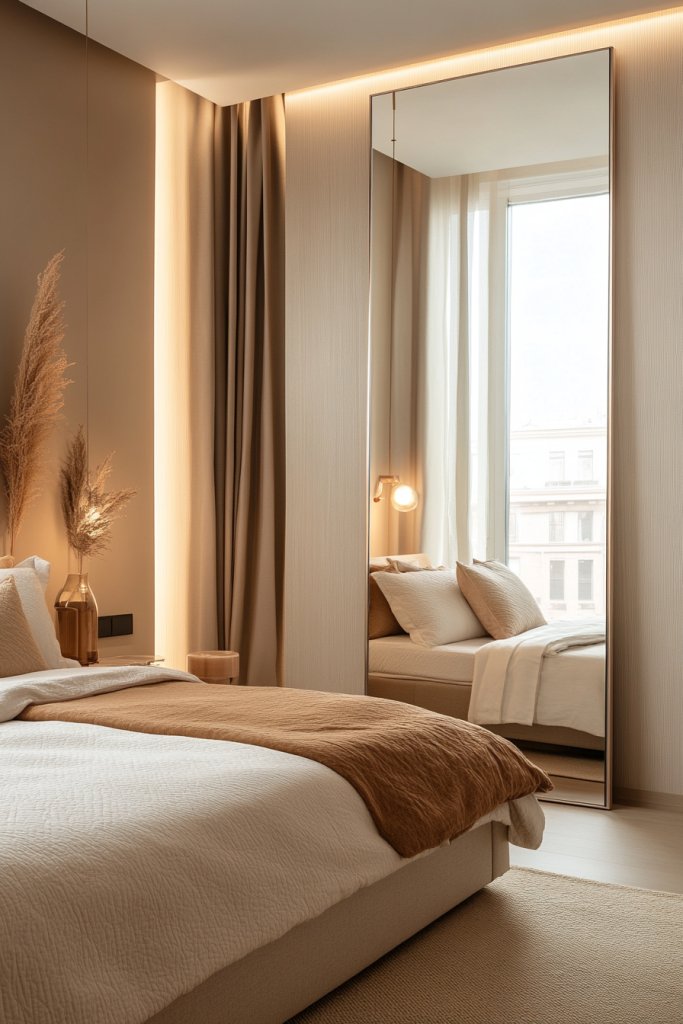
A well-placed mirror can transform a minimalist bedroom by amplifying natural light and creating the illusion of more space. When chosen thoughtfully, it becomes both a functional and decorative element that complements your serene design.
Picture a large, frameless mirror with clean edges, hung directly on the wall or leaning against it—perhaps in a matte black, slim metal, or simple wooden frame. The mirror’s reflective surface captures light from windows or lamps, brightening the room and emphasizing its openness.
When positioned opposite a window or a light source, it enhances brightness and airiness. Its sleek, unadorned look aligns perfectly with minimalist principles, adding subtle sophistication without visual noise.
The mirror’s size and placement should create a focal point, drawing the eye and making the space feel larger and more inviting. To incorporate this, select a mirror that fits your space and style—large enough to reflect the room’s key areas, but not overwhelming.
Mount it securely at eye level, ensuring it complements your other furniture and decor. Keep the surrounding area clutter-free to maximize its impact.
You might also consider a frameless option for a seamless look or a simple frame in neutral tones for added texture. With minimal effort, a mirror can significantly elevate your bedroom’s sense of calm, light, and spaciousness.
9. Keep Decor Accessories to a Minimum with Thoughtful Accents

In a minimalist bedroom, less is more—carefully chosen decorative accents can add personality without cluttering the space. The goal is to create a sense of calm through simplicity and intentionality.
Envision a few carefully selected objects—perhaps a single ceramic vase with a subtle texture, a small sculptural piece, or a textured woven basket. These accents are in neutral shades like matte white, soft beige, or muted gray, complementing the overall color palette.
Each item adds visual interest and warmth, but their sparing use maintains the room’s tranquil feel. Textured textiles, like a chunky knit throw or a simple linen pillow, provide tactile comfort and subtle contrast.
By limiting decor to only a handful of meaningful objects, the space avoids visual overwhelm and fosters serenity. To achieve this, start by decluttering surfaces and choosing a few key accents that resonate with your style.
Opt for quality over quantity, selecting pieces with simple shapes and natural materials. Place these objects thoughtfully—on bedside tables, shelves, or dressers—ensuring they don’t create visual noise.
Regularly evaluate your decor, removing anything that doesn’t contribute to the room’s calm aesthetic. This mindful curation ensures your bedroom remains a peaceful haven, full of intentional, beautiful details.
10. Use Built-In Shelving to Reduce Visual Clutter
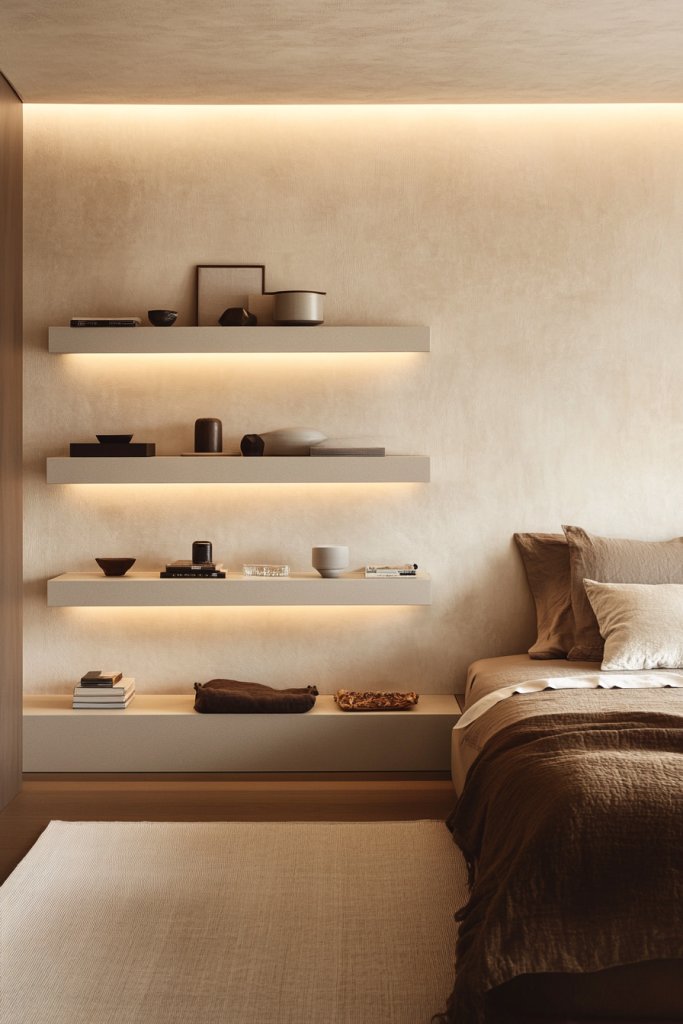
Creating a clean, minimalist aesthetic starts with smart storage solutions that hide away clutter, and built-in shelving is perfect for this purpose. By seamlessly integrating shelves into your walls, you eliminate bulky furniture pieces and keep surfaces clear, which visually expands the room and promotes serenity.
These shelves can be custom-designed to match your wall color or finished with natural wood for warmth, providing a sleek and cohesive look. When properly styled, they serve as a subtle display space for essentials and decorative objects without overwhelming the space.
Imagine a wall with recessed, floating shelves painted in the same neutral hue as the walls, offering a streamlined appearance. You might showcase a few carefully curated items—such as a ceramic vase, a stack of minimalist books, or a small sculpture—each piece thoughtfully spaced for balance.
The overall effect is an uncluttered, airy environment where everything has its place, and the eye is naturally drawn to the simplicity of the design. The textures of the materials—smooth surfaces paired with natural wood or matte finishes—add depth without visual noise.
To implement, start by measuring the wall space and deciding on the depth and height of your shelves. Choose built-in shelving units or custom carpentry for a seamless look, or install floating wall-mounted shelves if you prefer a DIY approach.
Use neutral-colored paint or veneer to match your room’s palette. Keep styling minimal—limit decor to functional or emotionally meaningful objects—and regularly tidy to maintain the calm, clutter-free vibe essential to a minimalist bedroom.
11. Choose Monochromatic or Limited-Color Bedding for Cohesion
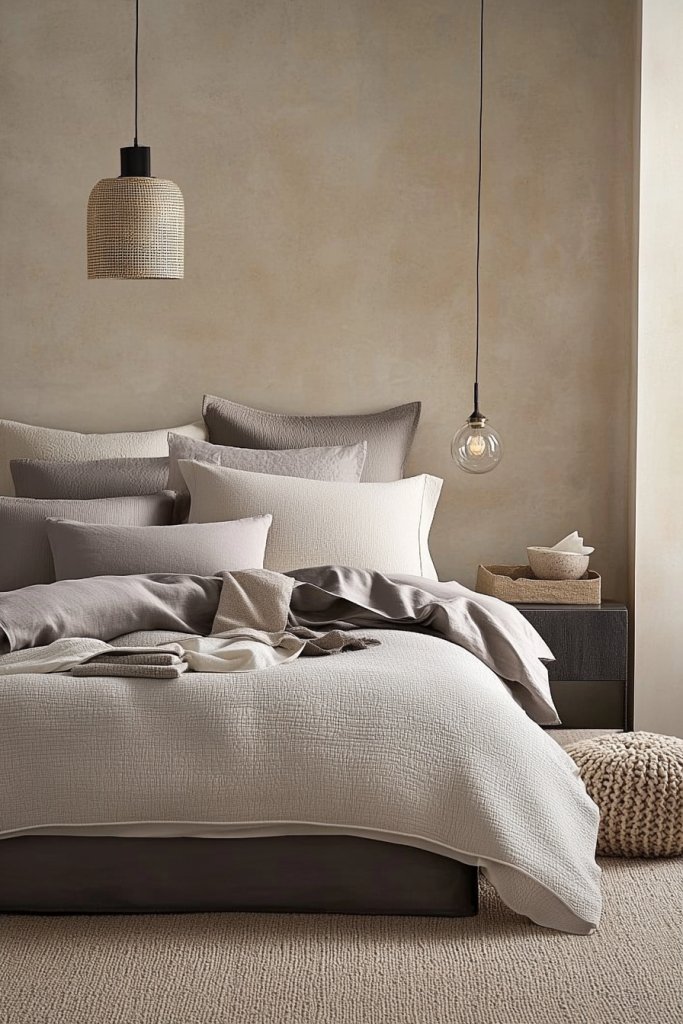
Selecting bedding in a monochromatic or limited color palette enhances the calm, cohesive atmosphere that’s central to minimalist design. Instead of mixing multiple bold hues, opt for shades within the same color family—such as soft greys, warm beiges, or crisp whites—to create a seamless, soothing look.
This approach reduces visual distraction, making the space feel more spacious and restful. Incorporate subtle variations in texture through different fabrics, like a smooth cotton duvet paired with a chunky knit throw, to add visual interest without breaking the calming color scheme.
Picture a bed dressed in a crisp white duvet cover, topped with a light grey throw blanket with a gentle ribbed texture, and matching pillowcases. The monochromatic scheme extends to other textiles in the room, like a pair of beige linen curtains or a taupe area rug.
These subtle tonal shifts make the room feel harmonious and inviting, encouraging relaxation. The overall effect is a quiet, elegant retreat where your eye isn’t pulled in multiple directions, but instead finds comfort in simplicity and uniformity.
To achieve this look, choose bedding in a single main color—like ivory, blush, or charcoal—and stick to it across all layers. Look for high-quality, natural fabrics such as linen, cotton, or bamboo that feel soft and breathable.
You can layer textures to add depth, but keep the color consistent. This simple, cohesive bedding style is easy to assemble and maintains a minimalist aesthetic effortlessly, creating a serene environment ideal for unwinding.
12. Integrate Hidden Cables and Outlets for a Tidy Look
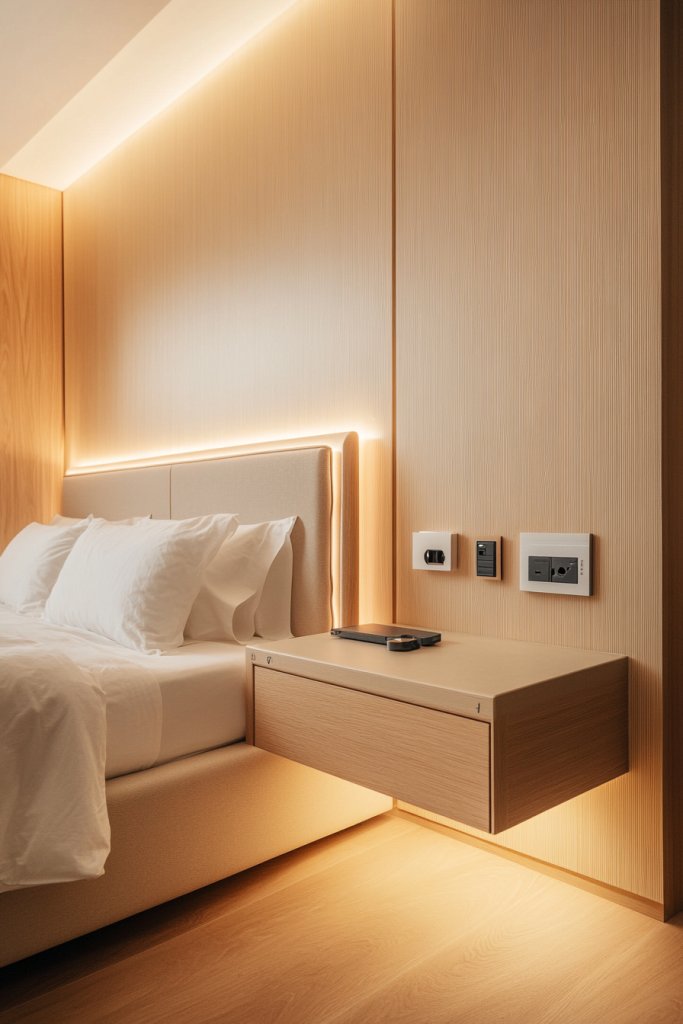
A cluttered bedside area with tangled cords instantly disrupts the minimalist vibe, but integrating hidden cables and outlets can keep your space sleek and serene. Concealing wires behind furniture or within wall channels ensures that electronics blend seamlessly into the room’s calming aesthetic.
Proper cable management not only improves visual appeal but also reduces hazards and makes daily routines more efficient. Achieving this neatness involves strategic planning of electrical outlets and thoughtful placement of devices.
Visualize a bedside table with a built-in cable management system, where charger cords and alarm clock wires are tucked away behind a discreet panel. Alternatively, install concealed power outlets directly into the wall or within the headboard, allowing devices like lamps, phones, and chargers to be plugged in without visible cords trailing across surfaces.
Use wire clips, sleeves, or adhesive cable organizers to keep remaining cords aligned and out of sight. The result is a tidy, clutter-free space that exudes calm and order.
For practical implementation, consider hiring an electrician to add extra outlets or install in-wall cable conduits if you’re comfortable with DIY. Use shorter cords or extension cords with a clean design to minimize excess length.
Keep surfaces clear of unnecessary electronics—only essential devices should be visible—and regularly check that cords are organized. This simple step enhances your bedroom’s serenity while maintaining the functionality needed for modern life.
13. Select Functional, Unobtrusive Closet Doors or Open Wardrobes
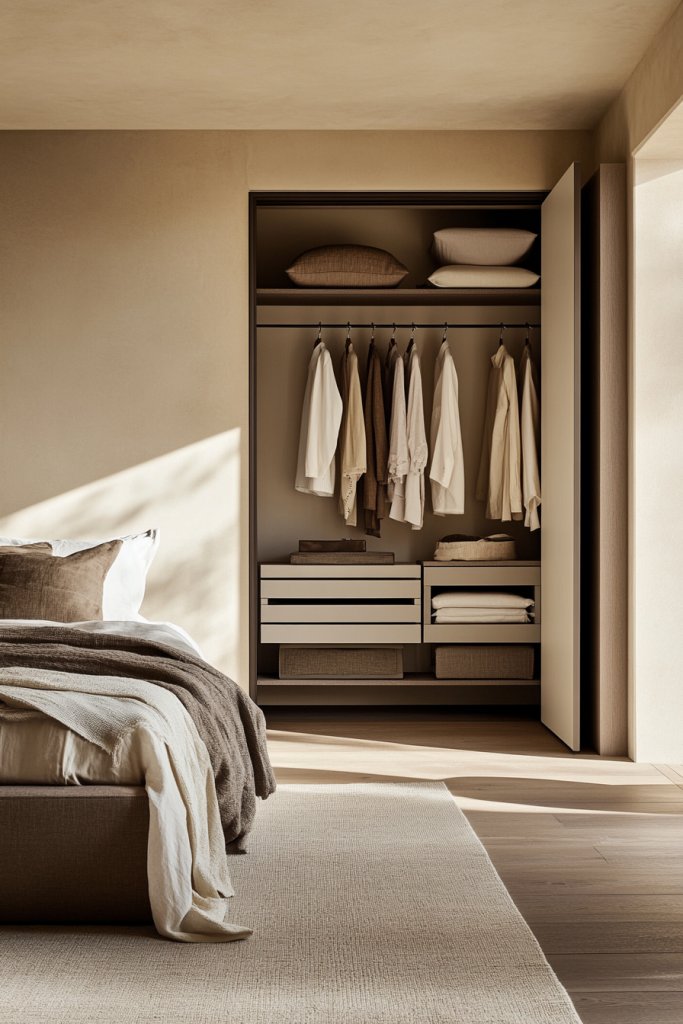
An uncluttered room relies heavily on smart storage solutions that don’t interrupt the visual flow, and choosing functional, unobtrusive closet doors or open wardrobes is key. Sliding doors, pocket doors, or minimalist panel doors in neutral tones can hide clutter without adding visual weight.
Alternatively, opting for an open wardrobe with neatly arranged clothing and storage baskets keeps the space feeling airy and accessible, especially when organized with uniform hangers and labeled boxes. Imagine a bedroom with sleek, matte black sliding doors that blend into the wall when open, revealing a neatly organized wardrobe with matching hangers and labeled storage bins.
Or visualize an open wardrobe featuring open shelving with folded textiles and minimalist storage baskets, keeping everything within reach yet visually tidy. The goal is to maintain a clean, streamlined look that supports the room’s calm atmosphere while offering practical storage solutions that don’t clutter the space.
To implement, choose sliding or pocket doors in materials matching your room’s palette—such as matte black, wood veneer, or painted MDF. For open wardrobes, invest in uniform hangers, clear containers, and baskets to keep items organized.
Keep clutter out of sight by regularly tidying and folding clothes or storing seasonal items elsewhere. Whether concealed or open, these options help keep your bedroom minimal and functional, reinforcing the overall peaceful vibe.
14. Add Subtle Metallic or Matte Finishes for a Touch of Elegance
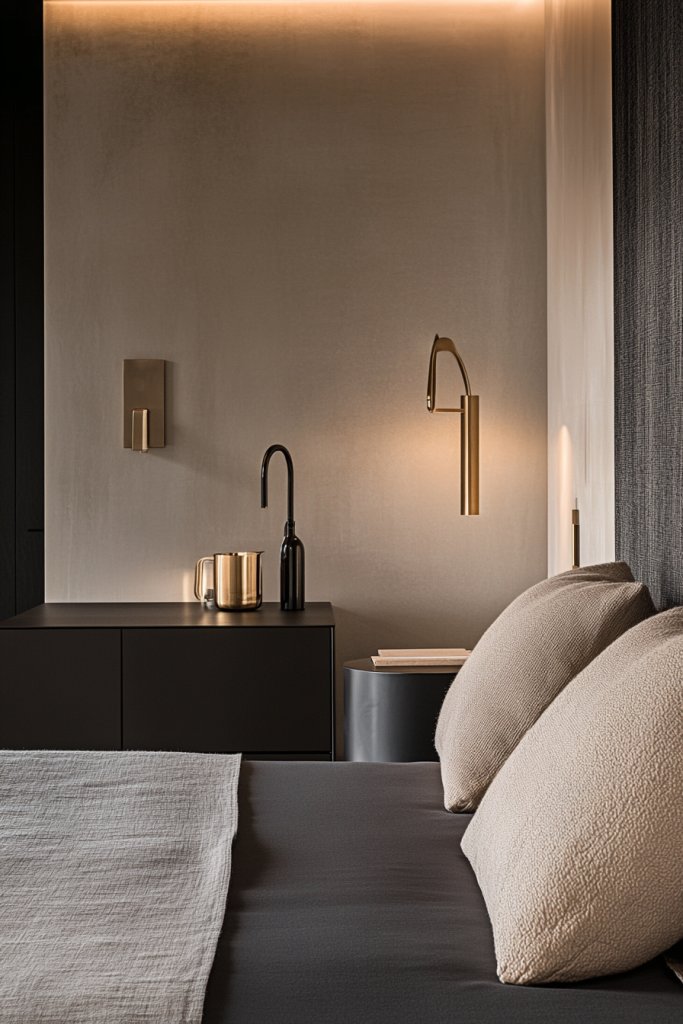
Incorporating subtle metallic or matte finishes elevates a minimalist bedroom with refined, understated elegance. Metal accents in finishes like brushed brass, matte black, or satin nickel add visual interest without overwhelming the space.
These finishes are ideal for hardware, light fixtures, or decorative accessories, creating a sophisticated contrast against neutral backgrounds. The key is choosing finishes that subtly catch the light, enhancing the room’s calm, polished aesthetic.
Picture matte black drawer pulls on a sleek dresser, or a brushed brass bedside lamp with a simple, geometric silhouette. These touches reflect light softly and add a layer of depth to the room’s overall design.
Combining matte and metallic elements with textured textiles and natural materials creates a balanced, luxurious feel that remains true to minimalist principles. The result is a space that feels both modern and timeless, with just enough detail to keep it visually engaging.
To incorporate these finishes, select hardware and fixtures in brushed brass, matte black, or satin nickel—materials readily available at hardware stores or online. Keep accessories minimal—perhaps a single metallic sculpture or a set of simple, metallic picture frames—to avoid visual clutter. These subtle accents enhance the room’s elegance without detracting from the serene, minimalist environment you aim to create.
15. Use Large-Scale Rugs in Neutral Tones to Anchor the Room
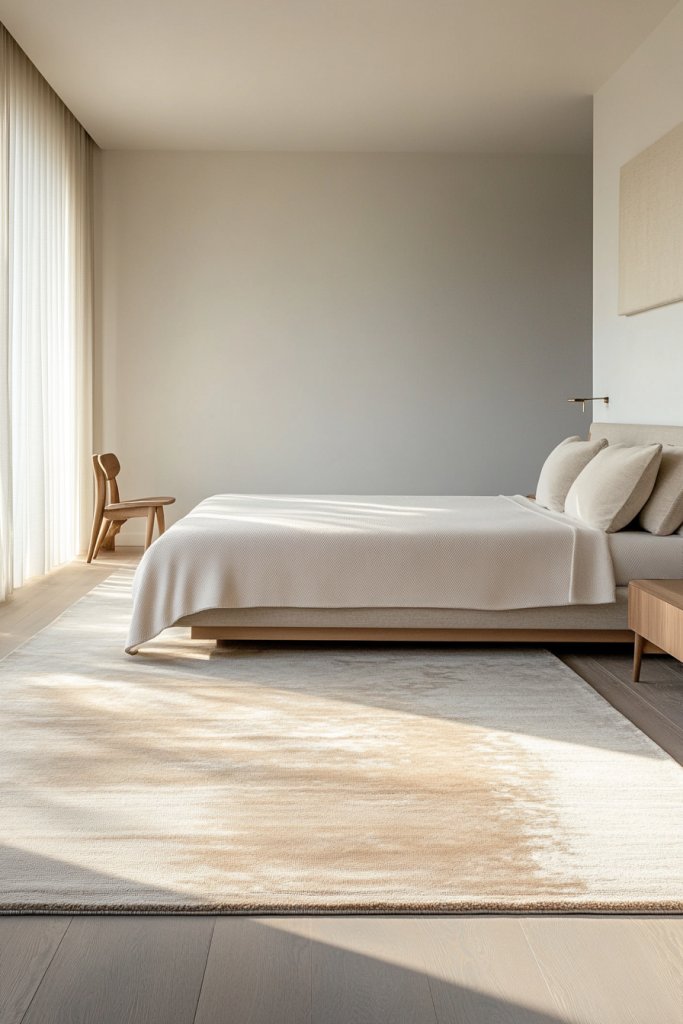
A large, neutral-toned rug can instantly ground a minimalist bedroom and add a layer of cozy sophistication. It’s more than just a floor covering—it sets the tone for the entire space, creating a sense of calm and cohesion.
When chosen wisely, it can also subtly define different areas within the room, making everything feel more organized and inviting. Imagine a plush, oversized rug in shades of soft beige, warm taupe, or cool greys spread out beneath your bed, extending beyond its edges.
The textured pile invites barefoot walks, while its muted hue complements the room’s neutral palette, enhancing the serene atmosphere. The tactile softness contrasts gently with sleek furniture and smooth flooring, providing a tactile and visual anchor that makes the space feel complete.
The rug’s subtle pattern or plain texture keeps visual clutter at bay, allowing other design elements to shine. To implement this, measure your space carefully and select a rug that covers at least the area beneath your bed and extends beyond it by a few inches on all sides.
Opt for materials like wool, jute, or synthetic fibers in neutral colors—these are durable and easy to clean. For a budget-friendly option, consider washable rugs or DIY options with rolled-up carpets. Place your rug before arranging your furniture for a polished, cohesive look that instantly elevates your minimalist sanctuary.
16. Incorporate Frameless or Minimalist Window Treatments
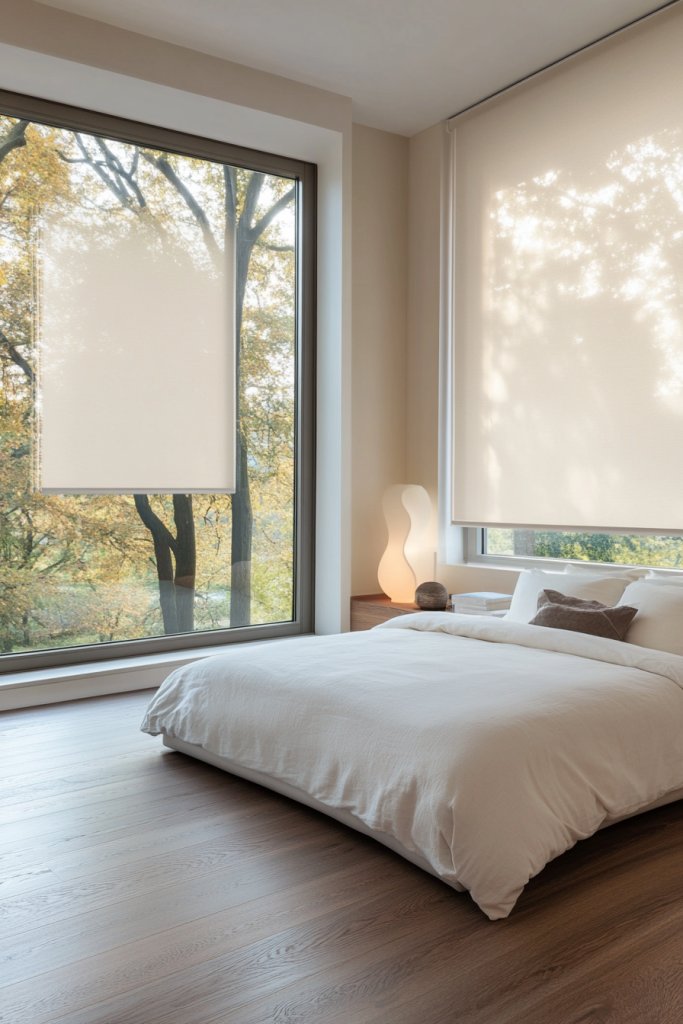
Streamlined window treatments are essential in a minimalist bedroom, as they allow natural light to flood the space while maintaining a clean, uncluttered aesthetic. Frameless or simple roller shades, Roman blinds, or sheer curtains in neutral tones create a seamless transition between indoors and outdoors, emphasizing the room’s openness.
Visualize sheer, white linen curtains gently draping from discreet ceiling-mounted rods, softly diffusing sunlight and adding a whisper of texture. Alternatively, sleek, frameless roller shades in matte white or soft gray roll up neatly when not in use, creating a crisp, modern silhouette.
These treatments blend into the wall, avoiding heavy fabric or ornate hardware that could disrupt the calm flow. The overall effect is airy, light-filled, and unobtrusive, perfect for a serene retreat.
For easy installation, measure your window frames precisely and select treatments that suit your privacy needs and light preferences. Roller shades or sheer panels are widely available at home improvement stores and online, often with simple mount options that require minimal tools.
Opt for materials like linen, cotton, or polyester blends for durability and ease of maintenance. Keep hardware discreet or hidden to preserve the minimalist aesthetic, making your windows a quiet, elegant focal point rather than an ornate feature.
17. Choose Minimalist Artwork or Photographs in Simple Frames
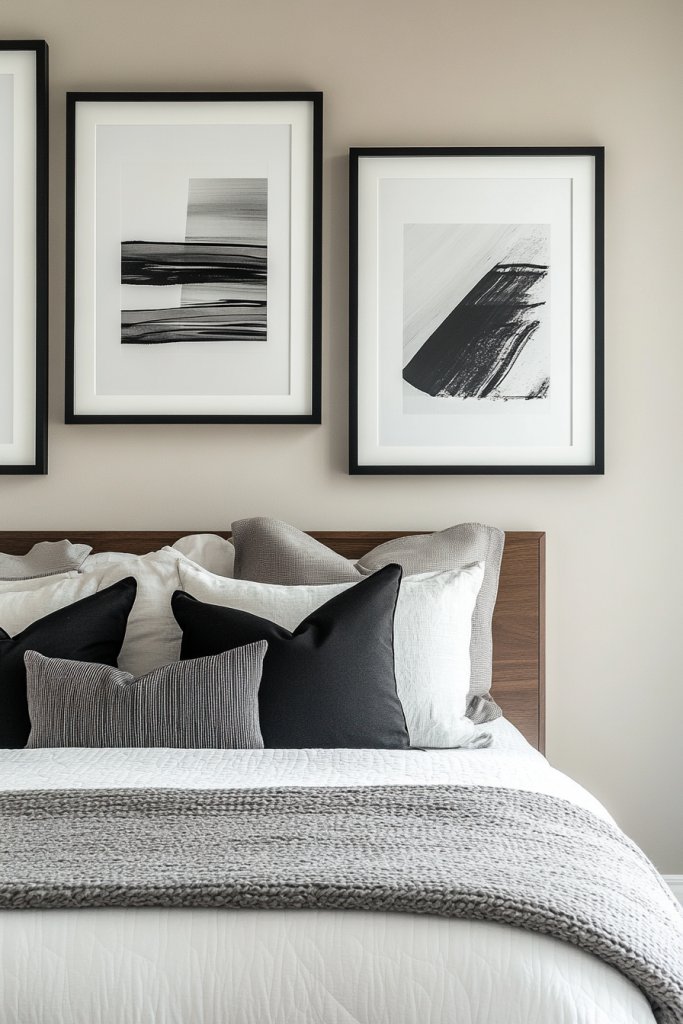
In a minimalist bedroom, artwork should enhance the sense of calm without overwhelming the space. Opt for simple, understated pieces—such as monochrome photographs, abstract prints, or subtle line drawings—that complement your room’s neutral palette.
Framing them in sleek, slim-edged frames in black, white, or natural wood keeps the look clean and cohesive. Picture a single black-and-white photograph in a slim matte frame, hung at eye level above the bed or on an empty wall.
The artwork’s subtlety invites quiet reflection, adds visual interest, and personalizes the space without clutter. Alternatively, a series of small, minimalist prints arranged in a grid creates a structured, balanced focal point.
The key is simplicity: avoid ornate frames or busy compositions that could disrupt the tranquil vibe. To incorporate this idea, choose artwork that resonates with your personal style and fits your space—digital prints, DIY designs, or affordable art from online sources work well.
Use matte black or natural wood frames for a modern edge, or go frameless with acrylic mounts for a sleek, contemporary look. Hang your art with minimal hardware, keeping wires hidden, and ensure the placement aligns with your eye level for the best visual flow. This approach adds quiet elegance and personality to your minimalist retreat.
18. Keep Surfaces Clear by Using Under-Bed Storage or Drawers
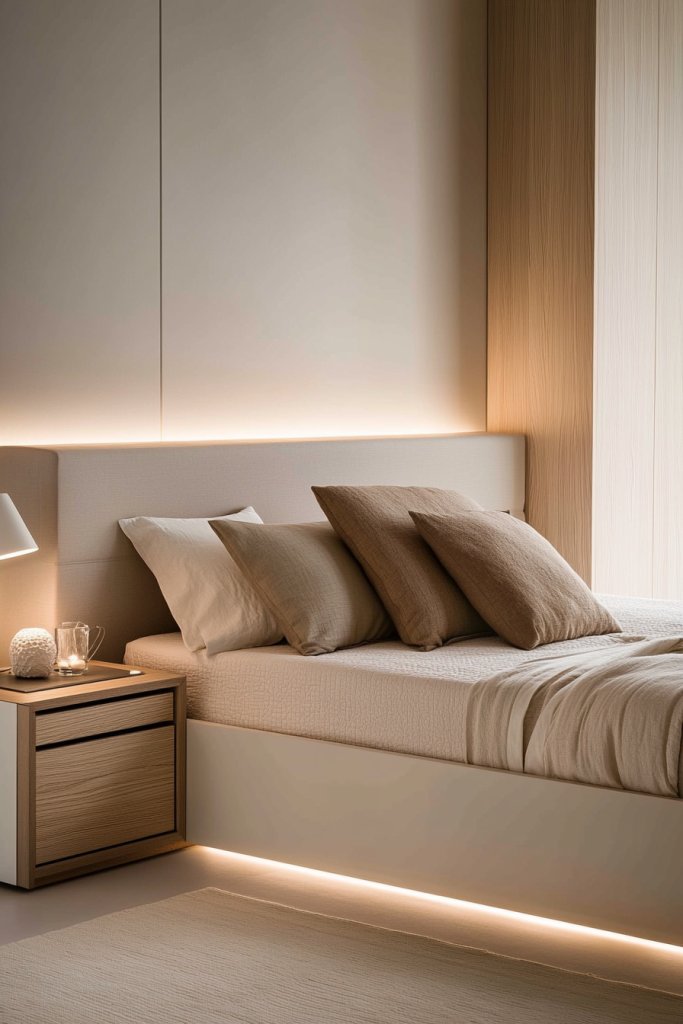
Clutter-free surfaces are the backbone of a minimalist bedroom, and utilizing hidden storage cleverly keeps everyday items out of sight. Under-bed storage or built-in drawers create a sleek, organized environment, reducing visual chaos and maintaining the room’s calm, uncluttered aesthetic.
Visualize a low-profile bed with integrated drawers or a spacious under-bed area filled with labeled, flat storage boxes. These containers in neutral tones—like fabric bins in beige or gray—blend seamlessly with your room’s palette.
The space beneath the bed becomes a secret storage hub, perfect for seasonal clothing, extra linens, or miscellaneous items, all kept out of view yet easily accessible. This method preserves the clean lines of your space and prevents surfaces like nightstands and dressers from becoming overloaded.
To implement, measure your bed frame’s clearance and choose storage drawers or flat containers that fit snugly underneath. Use clear plastic or fabric bins for quick identification, or opt for custom-built drawers for a seamless look.
Regularly declutter and organize your stored items to keep the space feeling fresh. This simple yet effective solution transforms your bedroom into a peaceful sanctuary free from visual distractions, making daily routines smoother and more serene.
19. Incorporate a Single Statement Piece, such as a Sculptural Lamp

Adding one bold, sculptural statement piece can elevate your minimalist bedroom’s aesthetic without cluttering the space. Whether it’s a unique lamp, a modern sculpture, or an artistic side table, this focal point introduces personality and visual interest while maintaining harmony.
Imagine a sleek, concrete or matte black sculptural lamp with an interesting geometric form, placed on your bedside table. Its distinctive shape draws the eye, creating a sense of curated sophistication.
Alternatively, a minimalist ceramic sculpture or a bold tabletop lamp with a sculptural silhouette can serve as the room’s centerpiece. This singular piece acts as an anchor for your design, balancing simplicity with a touch of artistry.
To choose and place your statement piece, consider your room’s color scheme and overall style. Select a statement lamp or sculpture in materials like ceramic, metal, or matte finishes that complement your existing furniture.
Keep other decor minimal around it to let it shine—this piece should stand out as a focal point. Position it thoughtfully on your nightstand or a side table, and enjoy how one striking object can transform your bedroom into a thoughtfully designed retreat filled with subtle elegance.
20. Use Geometric or Abstract Decorative Objects for Visual Interest

Adding geometric or abstract decorative objects is a fantastic way to introduce visual intrigue into a minimalist bedroom without cluttering the space. These pieces serve as focal points that draw the eye and add depth to the room’s clean aesthetic, keeping the overall look modern and refined.
They also provide a subtle artistic flair that elevates the serenity of the environment, making it feel thoughtfully curated rather than plain. Imagine a sleek, matte black ceramic sculpture with angular lines sitting on a simple nightstand, or a set of geometric brass candleholders arranged on a shelf.
Textured concrete or marble objects with clean shapes in neutral tones—like hexagonal coasters or faceted vases—bring a tactile dimension that complements a soft, monochromatic palette. These items can be small and unobtrusive or larger statement pieces, but they all contribute to a balanced visual rhythm.
The key is choosing objects with simple shapes and subtle finishes that enhance the minimalist vibe while adding just enough interest to prevent monotony. To incorporate these decorative objects, start by selecting a few key pieces that reflect your personal style—think geometric planters, faceted glass containers, or abstract sculptures.
Place them thoughtfully on nightstands, shelves, or atop dressers, ensuring they don’t overcrowd the space. Keep the color scheme neutral—black, white, matte gray, or metallic finishes—to maintain harmony. You don’t need many; often one or two well-chosen objects are enough to add a sophisticated, artistic touch to your serene bedroom.
21. Maintain Symmetry in Furniture Arrangement for a Balanced Feel
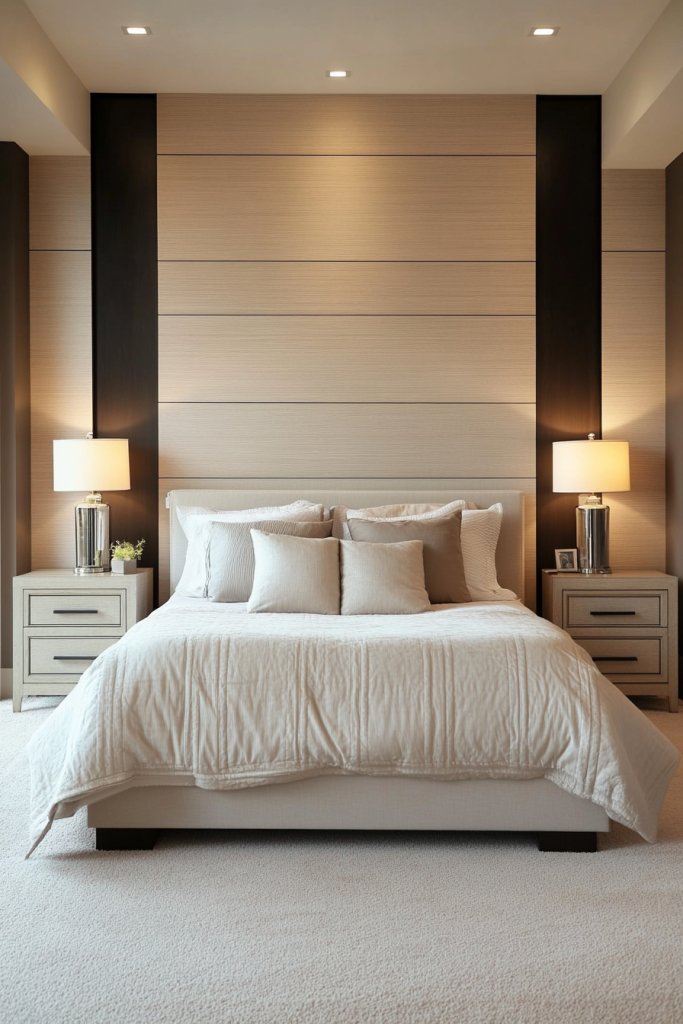
Creating symmetry in your bedroom furniture arrangement is a powerful technique to evoke a sense of calm and order, which is central to minimalist design. When furniture pieces are balanced and aligned, the eye naturally finds comfort and stability, making the space feel more inviting and harmonious.
Symmetry also simplifies the visual flow, helping your room appear more spacious and uncluttered. Visualize a bed centered against the wall, flanked by matching nightstands on each side, with identical lamps sitting atop them.
Additional elements like matching artwork or decorative objects on either side reinforce this symmetry. Keep furniture proportions in balance—avoid oversized pieces that overwhelm the space—and aim for clean lines and simple shapes.
The arrangement should feel effortless but intentional, with each element contributing to a cohesive, balanced aesthetic that promotes relaxation. To achieve this, start by placing your bed as the focal point and then position matching nightstands on either side.
Use identical lamps, perhaps with soft, warm bulbs, to create gentle ambient lighting. Keep other furniture, like dressers or chairs, aligned symmetrically or balanced across the room.
This approach not only enhances visual stability but also simplifies decorating—adding matching textiles or accessories on each side helps reinforce the overall harmony. The result is a tranquil, well-organized retreat that feels both intentional and effortless.
22. Keep the Overall Space Open and Uncluttered to Enhance Serenity
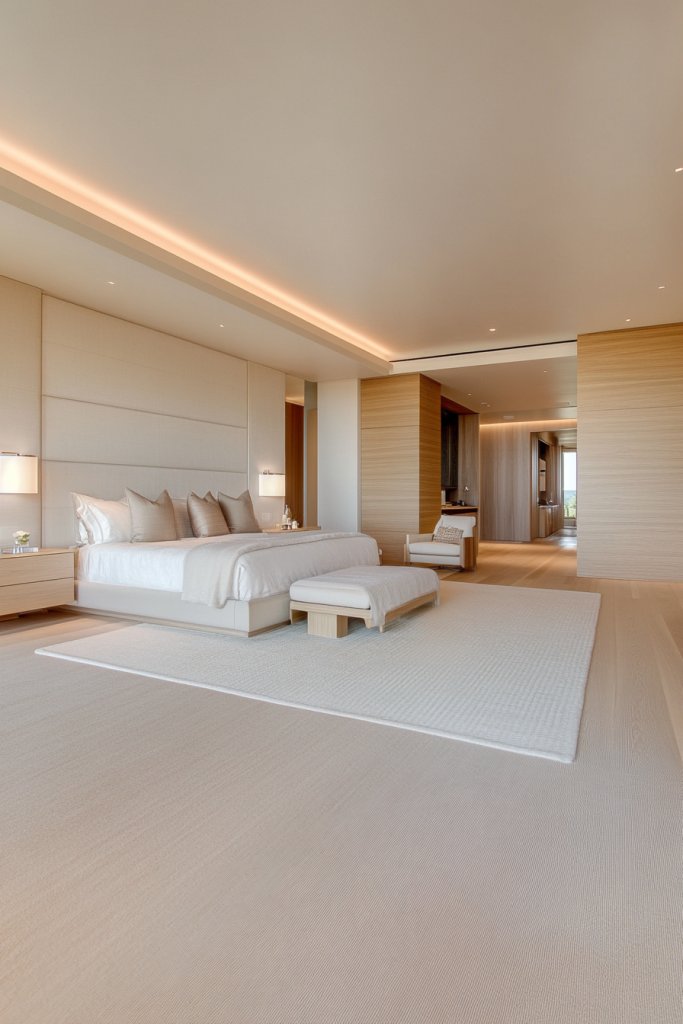
The essence of a serene minimalist bedroom lies in its openness and lack of clutter, creating an environment that feels spacious and peaceful. An open space allows natural light to flow freely, highlighting clean surfaces and simple lines, which collectively foster a calming atmosphere perfect for rest and relaxation.
Maintaining this sense of openness involves thoughtful organization and a disciplined approach to decor. Imagine a room where every surface is clear, with only a few essential pieces—perhaps a low-profile bed, a sleek nightstand, and a large, plush rug—giving the space room to breathe.
Storage solutions like under-bed drawers or built-in shelves keep belongings out of sight, maintaining a tidy appearance. Choose furniture with slim profiles and avoid overcrowding corners or walls.
Regularly editing your decor to remove unnecessary items ensures the room remains calm and inviting, avoiding the chaos that can disrupt serenity. To keep your space open, start by decluttering and establishing designated storage for every item.
Use minimal furniture—opting for pieces with clean lines and neutral finishes—and keep decorative accessories few and meaningful. Incorporate large, neutral-toned rugs to anchor the room visually and add softness without crowding. Finally, cultivate a habit of regularly reassessing your space to remove non-essential objects, ensuring your bedroom remains a peaceful sanctuary free from visual clutter and distractions.
Conclusion
By embracing a neutral palette, sleek furniture, clever hidden storage, and thoughtful accents, these minimalist bedroom ideas can transform your space into a sanctuary of serenity. Incorporating soft lighting, balanced symmetry, and subtle textures creates a calming atmosphere that promotes relaxation and peace.
Don’t hesitate to try these simple yet impactful design tips to craft a tranquil retreat tailored to your style. Start today and elevate your bedroom into a haven of effortless elegance and calm.
Leave a Reply